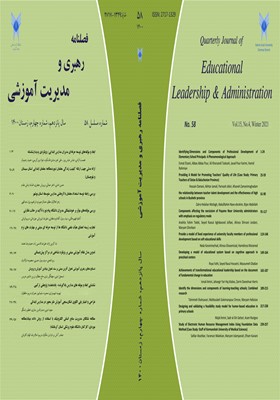Study of Electronic Human Resource Management Syndrome Using Foundation Data Method (Case Study: Staff of Kermanshah University of Medical Sciences)
Subject Areas :
صفدر آتش بر
1
,
فرامرز ملکیان
2
*
![]() ,
مریم اسلام پناه
3
,
الهام کاویانی
4
,
مریم اسلام پناه
3
,
الهام کاویانی
4
1 - دانشجوی دکتری مدیریت آموزشی، دانشکده علوم انسانی، واحد کرمانشاه، دانشگاه آزاد اسلامی، کرمانشاه، ایران
2 - استادیارگروه مدیریت آموزشی، دانشکده علوم انسانی، واحد کرمانشاه، دانشگاه آزاد اسلامی، کرمانشاه، ایران
3 - استادیار گروه مدیریت آموزشی، دانشکده علوم انسانی، واحد کرمانشاه، دانشگاه آزاد اسلامی، کرمانشاه، ایران
4 - استادیار گروه مدیریت آموزشی، دانشکده علوم انسانی، واحد کرمانشاه، دانشگاه آزاد اسلامی، کرمانشاه، ایران
Keywords: Electronic human resource management, Human Resource Management Index, Data Foundation, University of Medical Sciences,
Abstract :
The main purpose of this study was to study the electronic human resource management Index using data foundation method. To identify the components of electronic human resource management by referring to specialized texts of electronic human resource management including internal and external articles, books and publications, electronic human resource management indicators were identified, reviewed and summarized by kernel study method. In this study, the components were identified to the extent of theoretical saturation. Also, the interview method was used to be surer of the indicators. The selected experts were a group of experts from Kermanshah University of Medical Sciences who have taught at least 5 years in managerial positions. According to the results of the interview, finally, the syndrome of electronic human resource management in the data method of the foundation for the staff of Kermanshah University of Medical Sciences was identified. The results showed that among the comprehensive and general factors under study, two organizational factors and the leading factor of human resources information and communication technology in the development of electronic human resource management have an effective role. In addition, the results showed that various components of organizational factors such as agreement and support of the senior manager, proper understanding of electronic human resource management among senior managers, participation and coordination between different levels of the organization with the human resources unit, human resources training, the presence of capable managers In the use of human resource information systems have a very important role in the adoption and application of electronic human resource management.
آبتین، عبدالعزیز.(1391). ارائه مدلی برای توسعه مدیریت الکترونیک منابع انسانی در سازمانهای دولتی ایران، پایاننامه دکتری، دانشکده مدیریت دانشگاه تهران.
تصدیقی، هومن. انصاری، مهسا. جهانشاه لو، محمدرضا. (1389). چالشها و فرصتهای منابع انسانی الکترونیک، مجله منابع انسانی، 7 (2): 34-14.
دیو، اولریش. واین، بروک. (1385). طرح ارزشآفرینی منابع انسانی، ترجمه مسعود بینش، افشین دبیری و رضا قرایی پور، تهران: نشر آهار.
رعدی افسوران، نقی. عشرت زمانی، محمد، فروهر، محمد. (1395). مطالعه عوامل و مؤلفههای اثرگذار بر توسعه مدیریت الکترونیکی منابع انسانی، پژوهشهای مدیریت منابع سازمانی 6 (3): 24-1.
رفیعی، مجتبی. صادقی، فرزانه. (1388). نقش مدیریت منابع انسانی در توسعه سیستمهای اطلاعات، مجله میثاق مدیران، 11 (1): 57-60.
صوفی، صنم. (1391). سنجش میزان آمادگی آموزش الکترونیک در دانشگاه گیلان با استفاده از روش فازی، پایاننامه کارشناسی ارشد، دانشکده مدیریت، مؤسسه آموزش عالی مهر البرز.
غلامی، اعظم. (1392). شناسایی عوامل حیاتی موفقیت در استقرار و توسعه مدیریت منابع انسانی الکترونیک در نظام آموزش عالی استان (مطالعه موردی: دانشگاه سیستان و بلوچستان)، پایاننامه کارشناسی ارشد، دانشگاه سیستان و بلوچستان، دانشکده مدیریت و حسابداری.
محمدعلی زاده، کیارش. (1390). اولویتبندی عوامل مؤثر بر بهکارگیری تجارت الکترونیک در شرکتهای کوچک و متوسط برای توسعه صادرات، پایان نامه کارشناسی ارشد، دانشکده مدیریت و حسابداری، دانشگاه علامه طباطبایی.
موسی خانی، محمد. مانیان، امیر. حسن قلی پور، طهمورث. میربها، امید. آبتین، عبدالعزیز. (1390). ارائه مدلی برای توسعه مدیریت الکترونیک منابع انسانی در سازمانهای دولتی ایران، پژوهشهای مدیریت عمومی، 4 (3): 41-62.
میرسپاسی، ناصر. سرافرازی، مهرزاد و فرهادی محلی، علی. (1391). مدیریت منابع انسانی الکترونیک ضرورتی اساسی در هزاره سوم، اولین همایش ملی حسابداری و مدیریت، دانشگاه آزاد اسلامی واحد نور.
Agarwal, S., & Lenka, U. (2018). "Managing organization effectiveness through e-human resource management tool-e-learning: indian cases a qualitative approach", International journal of social sciences, 4(1): 298-312
Azhar, N, M. (2019). "Factors Affecting the Acceptance of E-HRM in Iraq", International Journal of Business a social science, 9(2):264-276
Hamad. Y., Aboobaider, B. M., Abd Ghani, M., Doheir, M. & Elzamly, A. (2019). "Controlling electronic human resource management (E-HRM) issues-based cloud computing system by using bayesian regression for healthcare organizations", Religacion, 4(17): 865-884
Heikkilä, J. P. (2013). Perspectives on e-HRM in MNCs, Doctoral thesis, University of Vaasa, Vaasa, Finland. Retrieved from http://www.uva.fi /materiaali/pdf/isbn_978-952-476-472-8.pdf.
Iqbal, N., Ahmad, M. & Muhammad, R. (2018). "Does e-HRM improve labour productivity? Astudy of commercial bank workplaces in Pakistan", Employee Relations, 41(2): 123.
Iqbal, N., Ahmad, M., Raziq, M. & Borini, F. (2019). "Linking e-hrm practices and organizational outcomes: empirical analysis of line manager’s perception", Review of business management, 21(1): 48-6
Johnson, D. L., Stone, Deadrick, D. L., Lukaszewski, K. (2016). "The influence of technology on the future of human resource management", Human Resource Management Review, 25 (1): 216-231
Kane, G.C., Palmer, D., Phillips, A.N., Kiron, D., Buckley, N.: (2015) Strategy, not technology, drives digital transformation, MIT Sloan Manage, 14: 1–25.
McDonald, k., Sandra Fisher, S. & Catherine, E. (2017). "e-HRM Systems in Support of Smart Workforce Management: An Exploratory CaseStudy of System Success", In Electronic HRM in the Smart Era. Published online.
Shaumya, K. & Anton Arulrajah, A. (2018). "The Impact of Electronic Human Resource Management (e-HRM) Practices on Bank’s Environmental Performance", Journal of Business Studies, 2(1): 33-50
_||_
